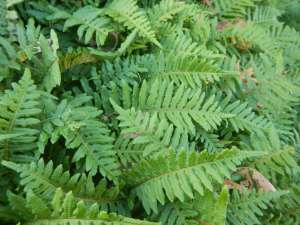When we first moved to the slopes of Mt. Tolmie, lush licorice fern decorated the mossy rock outcropping in our side yard.

Urban deer wandered the neighbourhood. They spent long afternoons hanging out at the top of our rock, chewing their cud & enjoying the safety of the vantage point.
The licorice fern flourished. The deer seemed uninterested. Typically deer aren’t interested in licorice fern. Typically.

A dozen years pass & their family grows. The large buck has several generations of grandkids browsing the neighbourhood.
Just down the street, beside a busy pathway to the college, licorice ferns still flourish on a similar rock outcrop.

Perhaps the deer don’t linger there?
Looking more carefully, I find a couple fronds that have been munched. Mostly the ferns are full-sized & healthy.

On our chunk of rock – where several more deer now hang out – – the licorice ferns are small, nibbled and struggling.
Coincidence?
Perhaps they’re less ‘deer resistant’ than I think.

A couple years ago, I shifted a few small mats of licorice fern from our rock to other spots around the garden. In places where the deer rarely linger, the ferns grow to their regular size. Hmmmmmm.

Deer aren’t typically interested in licorice fern…
- unless there’s a dense population of deer…
- and the hyper-active fawns just want to taste everything…
- and the herd’s favourite hangout is carpeted in licorice fern…
THEN deer can have a negative impact on licorice ferns.
Just because a plant is considered deer resistant, doesn’t mean it won’t suffer when the population of deer intensifies.

That’s my guess.
But really, who knows for sure?
Maybe it’s the raccoons?
Or squirrels?
Rabbits?
Ravens? Cats?
Maybe I’m just blaming deer because I notice them so often.
-30-
Some other ‘resistance’ musings:


